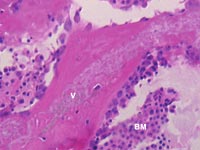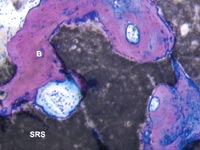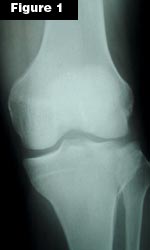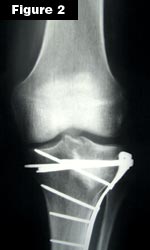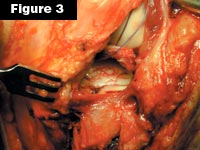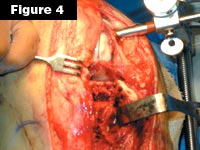Calcium phosphate bone graft substitutes continue to evolve
They have been used for years, but newer, more sophisticated products have become available more recently.
|
|
When it comes to synthetic bone graft substitutes, the most rapidly expanding category consists of products based on calcium sulfate and tricalcium phosphate. Whether in the form of injectable cements, blocks or morsels, these materials have a proven track record of being effective, safe bone graft substitutes for selected clinical applications.
The Norian Skeletal Repair System (SRS) was approved several years ago to treat low-impact unstable metaphyseal distal radius fractures in cases where early mobilization was indicated. It is a fast-setting carbonated apatite cement that hardens to form dahllite, which closely replicates the mineral phase of bone. SRS is designed to gradually remodel to bone in the body via osteoclastic resorption. In 1999, Norian was acquired by Synthes-Stratec.
“Among the injectable, bioactive cements, SRS is the best characterized. There are quite a few published studies that document its histology in preclinical models and in human biopsies. … It cures in vivo without an exothermic reaction and it develops compressive strength,” said Thomas Bauer, MD, PhD, an orthopedic pathologist at the Cleveland Clinic.
The approval of SRS was based on a prospective, randomized, multinational clinical trial that included 323 fracture patients, 161 of whom were treated with SRS. The remaining patients were treated with conventional methods, and all patients were monitored for a one-year follow-up period.
Grip strength
In Summary
|
Patients in both groups demonstrated approximately 89% of the grip strength in their treated wrist as they had in their untreated wrist. SRS-treated patients suffered greater loss of reduction than patients treated with conventional fixation, but the difference was not statistically significant.
Results also showed that extraosseous SRS was visible radiographically in 112 of the 161 patients, most commonly in the dorsal soft tissues adjacent to the fracture. It was completely resorbed in 83 of the 112 patients and partially resorbed in all others at 12 months. Since its approval, SRS has also been used for metaphyseal fractures of the tibial plateau, the calcaneus and the proximal femur.
Kyle F. Dickson, MD, of the Tulane University School of Medicine, described a paper he submitted on SRS to the annual meeting of the American Academy of Orthopaedic Surgeons. About 80 patients with posterior wall acetabular fractures participated in the study; half were treated with SRS and half were treated with bone graft.
“We couldn’t find any significant difference between the two groups, but I’m still not as happy with this as I could be. I would like it to be a putty that would then get hard and also have some inductive properties,” he said.
BoneSource
In 2002, Dickson published a study in The Journal of Trauma Injury, Infection and Critical Care on BoneSource BVF (Bone Void Filler) from Stryker Orthopaedics, another calcium phosphate-based cement. BoneSource is indicated only for bony voids or gaps that are not intrinsic to the stability of the bony structure.
| ||||
Dickson’s prospective, randomized study focused on 38 patients who sustained an acute closed or open type I fracture of the humerus, radius, ulna, femur, tibia or calcaneus and had a traumatic bone void requiring grafting. Open reduction and internal fixation was performed using either autograft or BoneSource.
Patients treated with BoneSource had an 83% success rate in maintaining reduction compared to a 67% success rate in patients treated with autograft. A successful clinical outcome, as measured by a healed fracture with minimal to no pain, moderate to maximum function and no or minor donor-site complications, was seen in 69% of patients treated with BoneSource and in 57% of patients treated with autograft.
|
||||
Bauer said both BoneSource and SRS have compressive strengths about halfway between cancellous and cortical bone, and both are extremely osteoconductive. “The advantage of these cements is that you can inject them into a site that is loaded by compression, such as tibial plateau fractures or calcaneal fractures, which I think are among the best applications.”
But despite the promising results with these and other substitutes, Dickson said his first choice is still iliac crest autograft: “I like it because of the workability of the bone graft itself. What I’m looking for are really two things: I want something that is very osteoinductive, and I want something that gives me some structure as well.”
Another injectable bone cement is the recently approved Alpha-BSM (Bone Substitute Material) from ETEX Corp. It is a resorbable apatite calcium phosphate that can be used to treat trabecular bone defects, defects with two to three walls of surrounding well-vascularized bone and articular surface elevation applications with additional hardware. Like other calcium phosphate materials, it resorbs and is replaced with bone during the remodeling process.
Charles N. Cornell, MD, of the Hospital for Special Surgery, participated in a recently completed prospective, randomized trial evaluating Alpha-BSM in treating Schatzker II and III tibial plateau fractures. Alpha-BSM was compared to autogenous bone, and researchers looked for evidence of postoperative re-depression of the fracture.
“We actually stopped the study early because we were finding a higher incidence of postoperative depression or settling of the fracture site with autogenous bone compared to Alpha-BSM. The cements appear to work better, and that’s actually been corroborated by some biomechanical in vitro studies. It’s probably because the cements get a better fill of the fracture defect than autogenous bone does,” Cornell said.
|
||||
While injectable cements like Alpha-BSM are becoming more popular, some surgeons prefer using substitutes that come in blocks that can be shaped or in morsels that can be packed into defects. Bauer said Vitoss from Orthovita, which is composed of beta tricalcium phosphate, is a particularly well-characterized material that is both osteoconductive and resorbable.
|
“One of its strengths is that it has a combination of micro- and macroporosity. Macroporosity allows cells to be wicked up into it, so it lends itself to use as an osteoconductive cell carrier. It also has submicroscopic microporosity that helps transmit fluid pressure and fluid loads, which seem to be signals related to bone remodeling,” he said.
OsSatura from IsoTis OrthoBiologics is another morselized calcium phosphate ceramic; it was approved as an osteoconductive bone void filler last May. OsSatura is composed of approximately 80% hydroxyapatite and 20% beta tricalcium phosphate and is similar to human bone in both structure and chemical composition.
The tricalcium phosphate component allows for early dissolution of calcium and phosphate ions to stimulate bone ingrowth, but the structural integrity of the scaffold is retained by the slower-degrading hydroxyapatite component, thus reducing the risk of incomplete defect healing.
Dr. Bauer has a financial interest in the Norian Skeletal Repair System and is a paid consultant to Synthes-Stratec.

![Thomas Bauer, MD, PhD [photo]](/~/media/images/news/print/orthopedics-today/2004/04_april/bauer_70_90_1614.jpg) Thomas Bauer, MD, PhD, is
an orthopedic pathologist at the Cleveland Clinic.
Thomas Bauer, MD, PhD, is
an orthopedic pathologist at the Cleveland Clinic.